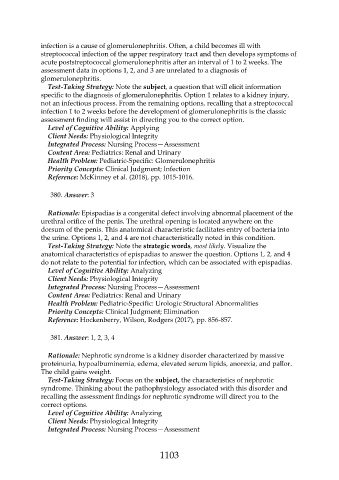Page 1103 - Saunders Comprehensive Review For NCLEX-RN
P. 1103
infection is a cause of glomerulonephritis. Often, a child becomes ill with
streptococcal infection of the upper respiratory tract and then develops symptoms of
acute poststreptococcal glomerulonephritis after an interval of 1 to 2 weeks. The
assessment data in options 1, 2, and 3 are unrelated to a diagnosis of
glomerulonephritis.
Test-Taking Strategy: Note the subject, a question that will elicit information
specific to the diagnosis of glomerulonephritis. Option 1 relates to a kidney injury,
not an infectious process. From the remaining options, recalling that a streptococcal
infection 1 to 2 weeks before the development of glomerulonephritis is the classic
assessment finding will assist in directing you to the correct option.
Level of Cognitive Ability: Applying
Client Needs: Physiological Integrity
Integrated Process: Nursing Process—Assessment
Content Area: Pediatrics: Renal and Urinary
Health Problem: Pediatric-Specific: Glomerulonephritis
Priority Concepts: Clinical Judgment; Infection
Reference: McKinney et al. (2018), pp. 1015-1016.
380. Answer: 3
Rationale: Epispadias is a congenital defect involving abnormal placement of the
urethral orifice of the penis. The urethral opening is located anywhere on the
dorsum of the penis. This anatomical characteristic facilitates entry of bacteria into
the urine. Options 1, 2, and 4 are not characteristically noted in this condition.
Test-Taking Strategy: Note the strategic words, most likely. Visualize the
anatomical characteristics of epispadias to answer the question. Options 1, 2, and 4
do not relate to the potential for infection, which can be associated with epispadias.
Level of Cognitive Ability: Analyzing
Client Needs: Physiological Integrity
Integrated Process: Nursing Process—Assessment
Content Area: Pediatrics: Renal and Urinary
Health Problem: Pediatric-Specific: Urologic Structural Abnormalities
Priority Concepts: Clinical Judgment; Elimination
Reference: Hockenberry, Wilson, Rodgers (2017), pp. 856-857.
381. Answer: 1, 2, 3, 4
Rationale: Nephrotic syndrome is a kidney disorder characterized by massive
proteinuria, hypoalbuminemia, edema, elevated serum lipids, anorexia, and pallor.
The child gains weight.
Test-Taking Strategy: Focus on the subject, the characteristics of nephrotic
syndrome. Thinking about the pathophysiology associated with this disorder and
recalling the assessment findings for nephrotic syndrome will direct you to the
correct options.
Level of Cognitive Ability: Analyzing
Client Needs: Physiological Integrity
Integrated Process: Nursing Process—Assessment
1103

